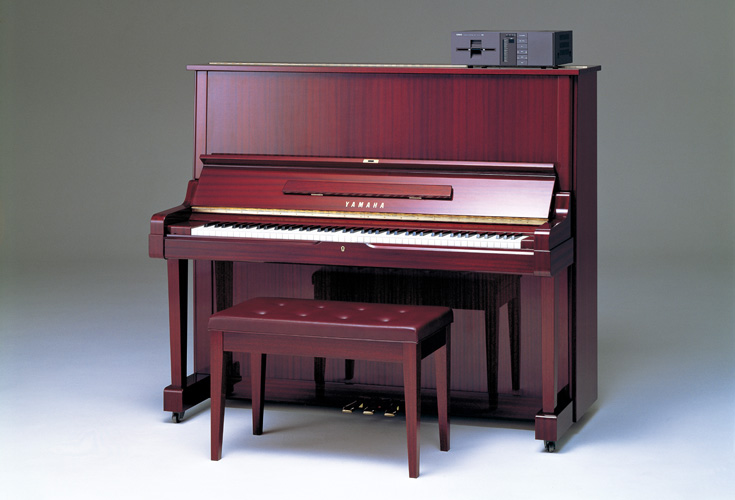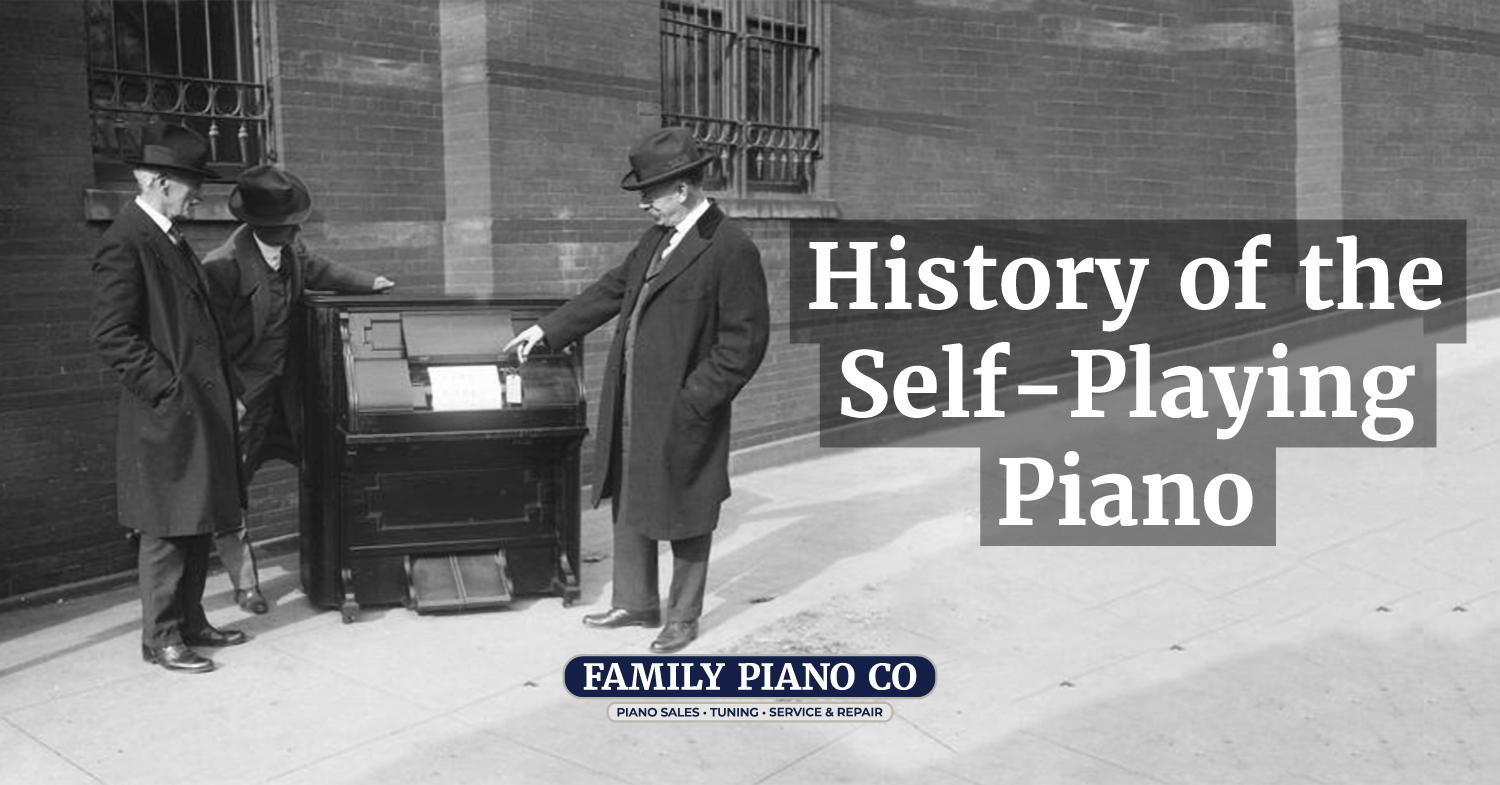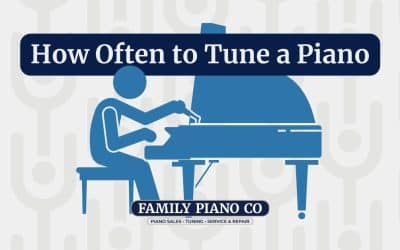It may be surprising to hear that the history of the self playing piano (also known as a player piano) goes back to 1895. They certainly weren’t the modern players we have today, but they did allow much of the same convenience!
A player piano is an entertaining addition to any home, allowing you to enjoy performances by your favorite artists. It also allows you to turn on live music that adds sophistication and richness that speakers can’t replicate. And in cases where the player piano is purchased for a beginner that doesn’t take to the instrument, a player piano allows you to make full use of it anyway!
In this article, we’ll go over a brief history and basic introduction to player systems: from antique player pianos with rolls to modern player pianos with Bluetooth.
What Do You Call a Piano that Plays Itself?
Starting off with the definition, a self playing piano is a piano that can play programmed music on itself thanks to an installed mechanism.
Demo of the Kawai CR-40 Crystal Grand Piano with a PianoDisc iQ Player System by Caruso Piano Gallery. As shown, player pianos can play themselves, and of course, they can be played by a person too.
Being a technology older than you might think, player pianos have also been referred to by other names such as:
- Pianola: This is a the first type of player piano that was popular in the early 20th century. It was produced by the Aeolian Company and featured a foot-pedal system that allowed the player to control the dynamics of the music.
- Reproducing piano: Later introduced by the Welte company in Germany, these pianos didn’t require any manual intervention thanks to the addition of an electric suction pump and an expression control mechanism. They marked a major technological advancements for player pianos, as pianists could now record work on music rolls. The Duo-Art player piano invented by Melville Clark is the most famous model.
- Self-playing piano: This is another term used to describe player pianos generally. It refers to the fact that the piano can play music without the need for a pianist.
Additionally, you may also hear them referred to by their specific brand. Some of the most popular player piano systems available today include the Steinway Spirio, Yamaha Disklavier, PianoDisc, and QRS. These pianos now use digital technology to produce music instead of the classic piano rolls we’ll cover in this article.
When was the Pianola Invented?
The earliest type of player piano was a device called a pianola. Also known as the Aeolian Player Piano, it was first invented around 1895 by Edwin Votey, American inventor and musician.
The pianola itself was actually a cabinet-like box mechanism that was placed in front of a piano. Through foot operation, it then played a song when fed paper rolls.

Original Pianola self playing piano mechanism being presented to Smithsonian Museum as gift by Edwin S. Votey the inventor (right, pointing) on December 7, 1922. Source: Wikipedia
Votey eventually sold the patent to this technology to the Aeolian Company, who soon after became the largest producer of player pianos in the world. It quickly gained popularity and even became a symbol of the “roaring twenties” in the United States.
Decline of Antique Player Pianos with Rolls
While extremely popular in the early 20th century, these older mechanical player pianos are basically antiques now.
Pianolas and then reproducing pianos rose in popularity up until radio and recorded music hit the mainstream in the 1920s. The Wall Street crash of 1929 was the final blow to the industry, and it marked the beginning of the end for many early player piano manufacturers.
For some extra reading, Pianola.com has a nice section on the history and development of early player pianos.
Today, there are some player pianos from the 1920s that have been well-maintained, and continue to work. It isn’t impossible to find them, but many technicians find it difficult to service them and finding piano rolls for sale can also prove to be a challenge.
Probably the most in-depth video available on how old player pianos worked. You can see why techs don’t particularly want to fuss with them! Note the mention of QRS — they’re best known for the PNOmation system now, but they started off making piano rolls after being founded by Melville Clark in 1912!
Invention of the Modern Player Piano
Thankfully in the 1970s, Teledyne developed the first commercially-available electronic player piano system. An early version was presented at the 1974 NAMM convention, and the rights to it were purchased by Superscope in 1977 who then marketed it as The Pianocorder.
In 1978, this system was made available on the Marantz Reproducing Piano, making that the first commercially-available modern player piano. Kits were also available for techs to install onto pianos afterwards.
Terrific demo and a brief history of the Pianocorder system installed on a Tokai AU-2 Upright Piano. You can see the Superscope Pianocorder system playing music from the cassette tape — and the complicated electronics underneath the action!
We also need to mention Wayne Stahnke, an American engineer who developed a cassette-based player system in the 1970s. This was used in the Bosendorfer 290SE (Stahnke Edition) Imperial Grand, the first of which was sold privately in June 1978. It’s possible this was the very first player piano by some months!
A good resource we found on early player systems was the first two sections of this thesis by Mark Fontana: Preservation and MIDI Translation of the Pianocorder Music Library.
Starting in 1979, Gary and Kirk Burgett saw success selling these Pianocorder kits and systems out of their store in California, Burgett Pianos.
Shortly after in 1987, not wanting to deal with competition, Yamaha bought Pianocorder to take it off the market. And soon after that, Burgett Pianos closed.
Then in 1988, Yamaha unveiled their first formal Disklavier system. It was the Disklavier MX100, built into their flagship Yamaha U1 48″ Upright Piano. Yamaha Disklavier pianos would go on to become the first mass-produced commercially-available player pianos.

Yamaha's first self playing piano was this U1 from 1982. They had installed an early version of the Disklavier (then simply known as "Player Piano").
Meanwhile, the Burgett brothers worked on their own electronic player piano system. And in 1989, they unveiled the first PianoDisc system.
Unlike the factory-installed Yamaha Disklavier system, it was an add-on kit that could be installed onto any piano. It was a huge success, and PianoDisc continues to be one of the most renowned player systems available today.
There isn’t a lot of information we could find on the very first PianoDisc system. But it’s easy to see that the Burgett brothers were able to come back from the Pianocorder setback! Read more about the system on their site: What is PianoDisc?
Fun fact about the Burgett brothers: they actually purchased Mason & Hamlin in 1996 to save it from going under! Kirk Burgett continues to be the CEO today.
Modern Self Playing Pianos Today
Any time a “player piano” is referred to now, it’s going to include the newer electro-mechanical systems.
These modern self playing pianos now allow for a much more accurate recreation of a pianist’s performance, as well as the ability to store and play back a virtually unlimited number of music recordings.
They’ve continued to evolve and improve over time too, incorporating new features such as internet connectivity, higher-resolution audio, and sophisticated software that allows for advanced customization.
QRS continue to be a pioneer in player piano technology, regularly releasing cool new features and mechanisms. QRS Connect is one recent example which allows a remote pianist to control a piano they aren’t directly playing.
Today, digital player pianos are a popular choice for musicians, music educators, and piano enthusiasts alike. They offer a wide range of features and capabilities that were simply unimaginable with older mechanical player pianos.
Is a Self Playing Piano Worth It?
If you love playing the piano and would also enjoy the convenience of being able to reproduce your favorite songs at whim, a self playing piano is a great use of money.
Modern player systems can add $5,000 – $10,000 to a piano’s price though. So if you’re interested in purchasing a player piano, it’s important to compare prices and features from different manufacturers and dealers — which can add some homework to your plate.
And if you’re purchasing an older player piano that plays floppy discs, CDs or even rolls, you’ll also have to consider how to find new music. It may prove to be inconvenient or even impossible doing so for some systems.
We do have a guide on Getting More Music for Your PianoDisc System if you have one of those!
Still, given you have the budget, a self playing piano is an easy recommendation for most people interested in an acoustic piano already. Best of all, it’s an upgrade that you can choose to install whenever, even if you don’t have the budget just now.
In life, there aren’t many shortcuts or ways to cheat progress. But buying a player piano does grant you the ability to enjoy piano playing without any practicing. That’s definitely gotta be worth something!





0 Comments